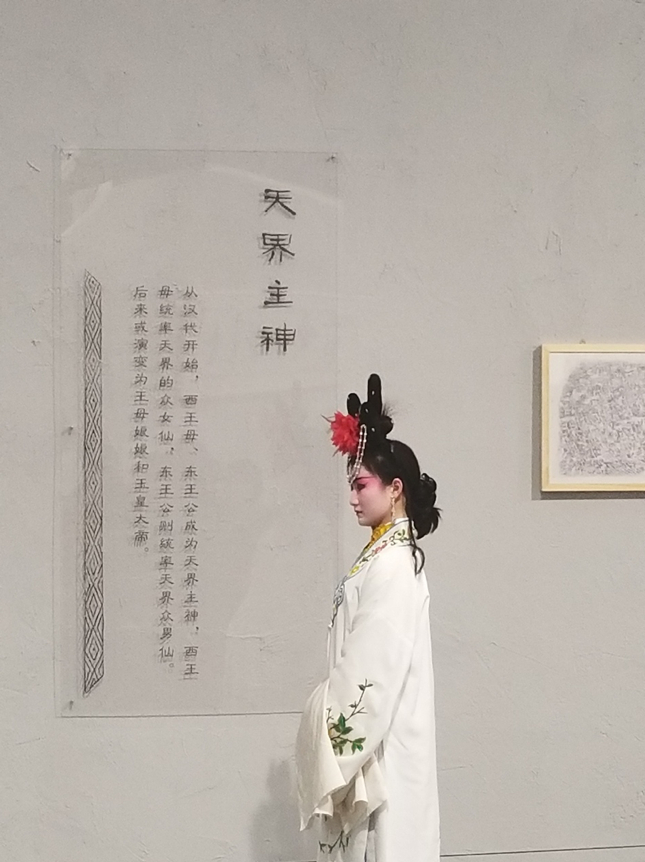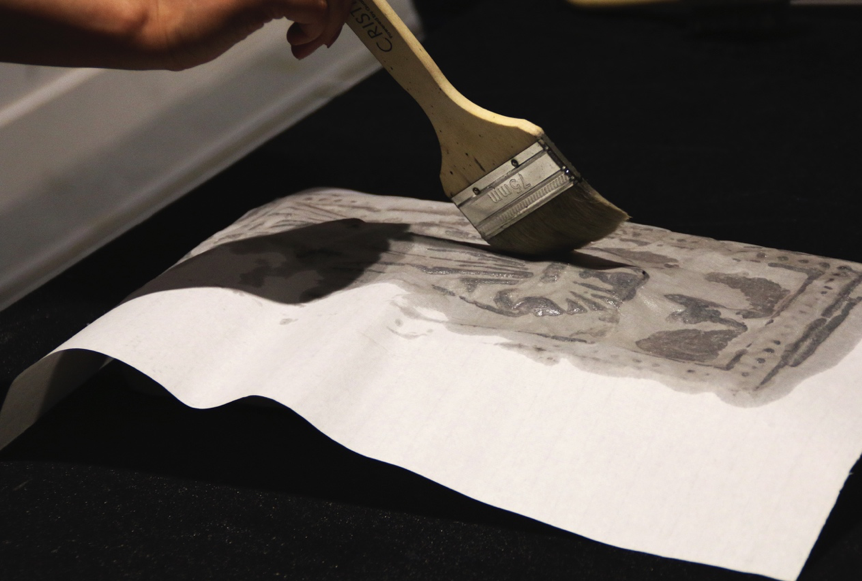With plaintive chord echoing in the hall, an actress moved like breeze, bringing back the whole audience to thousands of years ago. In distinct comparison with her shiny red face, the sweeping white robe made her expressions even more theatrically affecting. This immersive atmosphere created by the white-haired musician, Li Jinzhao and a talented young actress, who has been learning Chinese Opera for more than ten years, is just a glimpse of the seminar in Wanlin Museum on March 20th. The latest exhibition, from March 15thto May 2nd, of Han Dynasty’s Stone Reliefs unearthed at Nanyang County, alsograsps great attention from the public.

The actress waiting to perform
What to Preserve?
Far from being a prevalent art form, the stone reliefs of Han Dynasty seem to be out of spotlights. However, these historical relics have never lost ground for its close connection to Chinese public culture. The renowned scholar Jian Bozan called tombstone reliefs “the living portraits of the history of Han dynasty”. Not only the performance of traditional Chinese calligraphy was found in them, but also Pangu dance, musical instruments like Guqin and Suona, expressed their cultural charm through these carvings. Saved in stone, the sound and gesture from over two thousand years ago truly survived the erosion of time, ultimately achieving its prosperity.
Named as To See a World in a Grain of Sand, the exhibition displays the comprehensive connotations of Han culture and the Chinese spirit. The Han culture to Chinese people is as Greek and Roma to west civilization. As the well-known sculptor Wang Zhaowen once commented, tombstone reliefs from Nanyang can be considered as a peculiar cultural phenomenon, surprisingly able to embrace all interpretations from both the highbrow and the ordinary. All the impressions show the infinite possibilities to be explored from the tombstone reliefs.
Chinese writer Lu Xun once commented that only the stone engraving from Han Dynasty is truly magnificent and historically comprehensive. As the combination of sculpture and drawing, stone relief is a special form of art, by using knives instead of brush pen, and pursuing the verve and spirit of characters. Unlike conventional Chinese paintings that mainly convey the painters’ inner feelings and overall artistic context, these stone reliefs specifically depict the moments in people’s daily lives, which are more like a vivid story instead of a static image. Naturally, we can get immersed in them and imagine ourselves as one of the characters in the reliefs as well as experience their mundane yet interesting lives. Just as Prof. Wang Chenghao said, “When viewing these pictures, one should be a participant and be involved in them, rather than a mere observer that judges and makes comments. Even though they were from centuries ago, we could still understand the eternal joy of spring excursion and charming celebrations. ”

The exhibits of ancient ceremonies
How to Preserve?
The audience were also encouraged to join in the interactive activity of rubbing-making, the most common form of all the exhibits. “We find it a good way to enhance visitors’ understanding. From another aspect, as a traditional technique, rubbing can meanwhile show us how people have preserved culture.” Liang explained. The participants were asked to spread out a piece of Xuan paper on the inscriptions, whose stones had been brushed with Bletilla water. They had to strike the inscription with a bristle brush until the pattern fully appeared. When the paper was almost dry, they dipped the “rubbing bag” which was made of cotton and silk cloth with ink and knocked it gently on a ping-pong racket. The step of inking also required great care and patience so as to ensure every line on the stones was clearly visible, and they should tap the rubbing bag on the paper multiple times with precise control of strength. Based on the reaction of audience, this activity was the most popular.

An expert brushing the xuan paper
“What impressed me a lot was some of the captions,” Yi, a student from the School of Philosophy, said as she pointed to a painting, which was a portrait of a gatekeeper, with a shield held across his chest and a peaceful smile. Above his head flew a linnet and at the bottom sat a unicorn. On the left side of the painting a line was written, “Tired as I am, I would still receive you with a smile.” Liang explained, “we did add some funny witticisms as we collected the relics, because we hoped that the they could add some vividness to the exhibition.” Besides, an Emoji contest was held, in which the public could give new explanations to the ancient relics based on their own understanding. It is obvious that these new forms of public education could attract more attention.
Stories Behind the Exhibition
“It was a great pleasure for me to be selected as one of the curators of this exhibition. Thanks to the platform provided by Wanlin Museum, I was left a large room to process my own ideas,” said Liang Weiwei, a sophomore in the Department of Archaeology. Apart from excitement and eagerness, he also felt a little stressed out when taking on the task. “It was really a huge challenge since seldom does an undergraduate get the chance to hold an exhibition.” Having spent three months previously visiting over 120 exhibitions and preparing the proposal, Liang gradually formulated his framework of the display after several investigations in the Nanyang Institute of Cultural Relics and Archaeology, Nanyang Han Paintings Gallery and Xinye Han Stone Engravings Gallery. And his team was enlarged after Huang Yingying, a junior in the Department of World History, joined in. Besides, a few postgraduates who were interested in museums and cultural relics also offered to help.
Taking a closer look, it will be easy to find out the logic chain linking the three parts of the whole exhibition, the values, daily life and afterlife of Han people. “I think to hold an exhibition is to tell a story,” Liang said, “and we divided our exhibition into three parts. In the first section, the theme is introduced through some myths and ancient stories. The second part mainly describes some typical scenes of people’s life in Han Dynasty and the last part is about their understanding of nature and fantasies about the afterlife.” He also organized these items in the form of a series of questions: Who am I? Where do I come from? What are my life and afterlife like? Placement of exhibits had to be adjusted over and over again, as Liang said, “the truth is that some exhibits related to the second part were not available to us, while the number of paintings of gatekeepers was much larger than we needed. So, we also had to constantly change our minds in terms of what the exhibits originally told us.” Up until the opening day, Liang was working with his team members until midnight everyday and even changed two billboards overnight.

A corner of the exhibition
“We give ourselves a passing grade since we still have plenty of room for improvement, especially about how to interpret these paintings. But it is definitely a pleasure to know that people have enjoyed the exhibition. Instead of imparting our opinions on visitors, we prefer to offer enough room for them to make their own interpretations. For me, the profound lesson is to view cultural relics from a holistic perspective rather than to be confined to a single one. The value of the exhibit itself is important, but it could be undervalued without ‘telling a story’.” Liang concluded.
Echoing with the theme of this exhibition Returning, the core of traditional Chinese culture can be kept and revived again once it is passed on to the younger generations. As a first step, this exhibition in Wanlin Museum is a great attempt to spread diversified ancient art and spirit. Every time someone steps into the hall, one can definitely feel the ethnic culture returning to embrace us all.
(Photo by Wang Yujie)
(Edited by Li Minjia, Wang Wei, Edmund Wai Man Lai, Liu Jiachen and Liu Xiaoli)